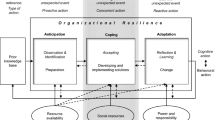Abstract
In the Tavistock tradition, we understand anorganization by first identifying its primary task. Weask, what is this organization set up to do, how is itorganized to accomplish this objective, and what unconscious dynamics limit or distort itsmembers' ability to do their work? This approach whilepowerful, does not help us understand organizations thatlive at strategic junctures in their life cycles. In these situations, the task is to choose atask. We need a conceptual framework to help usunderstand the psychodynamics of organizing and decidingin these situations. The following article develops the concept of the “primary risk”to explain how organizations behave in these situations.It links the primary risk to the psychoanalytic idea ofambivalence and the gestalt idea of the figure/ground relationship. It draws on case material toilluminate its concepts.
Similar content being viewed by others
REFERENCES
Carlton, J. Apple: The inside story of intrigue, egomania, and business blunders, New York: Random House, 1997.
Freud, S. Formulations on the two principles of mental functioning (standard ed., Vol. 12), pp. 1911, 218–226.
Freud, S. Mourning and melancholia (standard ed., Vol. 14), pp. 1917, 243–258.
Galbraith, J. R. Organization design, Reading: Addison-Wesely, 1977.
Kawasaki, G. The Macintosh way: The art of guerrilla management. New York: Harper Perrenial, 1990.
Lawrence, G. Management development: Some ideals, images and realities. In A. D. Colman and M. H. Geller (Eds.), Group relations reader 2, Washington, D.C.: A.K. Rice Institite, 1985.
Miller, E., & Rice, K. A, Task and sentient systems and their boundary controls, In E. Trist, and H. Murray (Eds.), The social engagement of social science (Vol. 1), Philadelphia: University of Pennsylvania, 1990.
Mossberg, W. Apple May Be Ripe for a Takeover. All Things Considered, National Public Radio Transcript, 01–27–1996, Washington, D.C., 1996.
Author information
Authors and Affiliations
Corresponding author
Rights and permissions
About this article
Cite this article
Hirschhorn, L. The Primary Risk. Human Relations 52, 5–23 (1999). https://doi.org/10.1023/A:1016916315243
Issue Date:
DOI: https://doi.org/10.1023/A:1016916315243




